VEGA FLEX81 User Manual
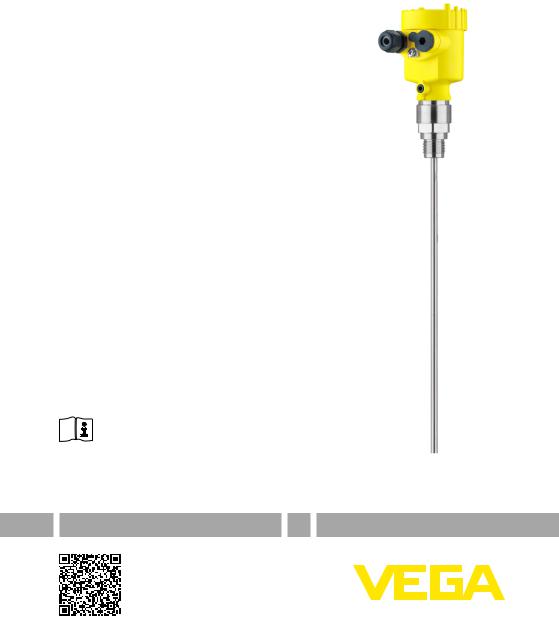
Operating Instructions
TDR sensor for continuous level and interface measurement of liquids
VEGAFLEX 81
HART - integrated accumulator
Document ID: 44640
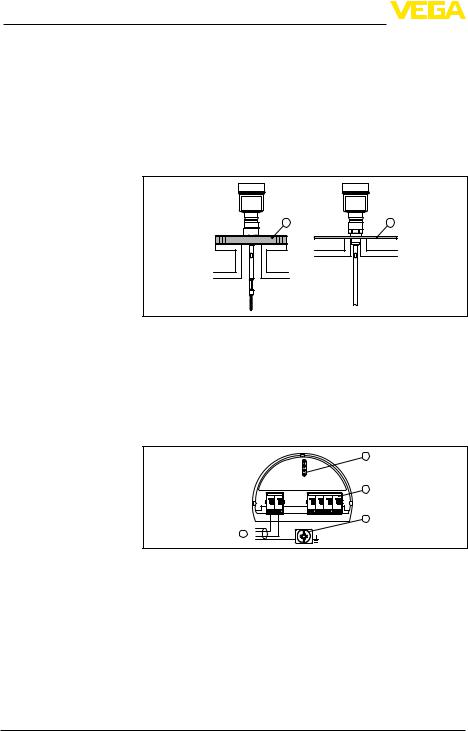
Quick start
Quick start
The quick start procedure enables a quick setup with many applications.You can find further information in the respective chapters of the operating instructions manual.
Mounting |
1. |
Distance from the metallic vessel wall > 300 mm.Distance from |
|
|
non-metallic vessel wall > 500 mm.The probe must not touch any |
|
|
installations or the vessel wall. |
|
2. |
Place a metal sheet beneath the process fitting with non-metal |
|
|
vessels. |
Electrical connection
Set parameters
2
1 |
2 |
Fig. 1: Installation in non-metal vessel
1Flange
2Metal sheet
3. If necessary, fasten probe end.
For further information see chapter "Mounting".
1.Make sure that the power supply corresponds to the specifications on the type label.
2.Connect the instrument according to the following illustration
2
4...20mA |
3 |
|
(+)1 |
2(-) |
5 6 7 8 |
4 |
1 
Fig. 2: Electronics and connection compartment, single chamber housing
1Voltage supply, signal output
2For display and adjustment module or interface adapter
3For external display and adjustment unit
4Ground terminal for connection of the cable screen
For further information see chapter "Connecting to power supply".
For standard applications we recommend selecting the "Quick setup" |
-44640 |
in the display and adjustment module. |
|
|
130430-EN |
VEGAFLEX 81 • HART - integrated accumulator

Quick start
1.In this menu item you can select the application.You can choose between level and interface measurement.
2.In the menu item "Medium - Dielectric constant" you can define the medium type (medium).
3.Carry out the adjustment in the menu items "Min. adjustment" and "Max. adjustment".
4.A "Linearization" is required for all vessels in which the vessel volume does not increase linearly with the level - e.g.in a horizontal cylindrical or spherical tank.Activate the appropriate curve.
5.A "False signal suppression" detects, marks and saves the false signals so that they are no longer taken into account for level measurement.We generally recommend a false signal suppression.
Parameterization example The sensor measures the distance from the sensor (reference plane) to the product surface.
44640-EN-130430
1 |
|
1 |
4 |
|
4 |
2 |
2 |
3 |
3 |
|
|
|
|
5 |
5 |
|
|
Fig. 3: Measuring ranges - VEGAFLEX 81
1Reference plane
2Probe length L
3Measuring range (default setting refers to the measuring range in water)
4Upper dead band (in this area no measurement is possible)
5Lower dead band (in this area no measurement is possible)
For this adjustment, the distance is entered when the vessel is full and nearly empty.If these values are not known, an adjustment with other distances, for example, 10 % and 90 % is also possible.Starting
VEGAFLEX 81 • HART - integrated accumulator |
3 |

Quick start
point for these distance specifications is always the seal surface of the thread or flange.
Further steps |
1. |
In the menu "Additional settings", menu item "Damping" you can |
|
|
adjust the requested damping of the output signal. |
|
2. |
Select the parameter of the current output and the output charac- |
|
|
teristics in the menu item "Current output". |
You can find additional information in chapter "Parameter adjustment".
130430-EN-44640
4 |
VEGAFLEX 81 • HART - integrated accumulator |

44640-EN-130430
|
|
|
|
Contents |
|
Contents |
|
|
|||
1 |
About this document |
7 |
|||
|
1.1 |
Function............................................................................................................................ |
|||
|
1.2 |
Target group...................................................................................................................... |
7 |
||
|
1.3 |
Symbolism used............................................................................................................... |
7 |
||
2 |
For your safety |
8 |
|||
|
2.1 |
Authorised personnel........................................................................................................ |
|||
|
2.2 |
Appropriate use................................................................................................................ |
8 |
||
|
2.3 |
Warning about incorrect use............................................................................................. |
8 |
||
|
2.4 |
General safety instructions................................................................................................ |
8 |
||
|
2.5 |
CE conformity................................................................................................................... |
8 |
||
|
2.6 |
NAMUR recommendations............................................................................................... |
9 |
||
|
2.7 |
Environmental instructions................................................................................................ |
9 |
||
3 |
Product description |
10 |
|||
|
3.1 |
Configuration.................................................................................................................. |
|||
|
3.2 |
Principle of operation...................................................................................................... |
11 |
||
|
3.3 |
Packaging, transport and storage................................................................................... |
13 |
||
|
3.4 |
Accessories and replacement parts................................................................................ |
14 |
||
4 |
Mounting |
15 |
|||
|
4.1 |
General instructions........................................................................................................ |
|||
|
4.2 |
Mounting instructions...................................................................................................... |
15 |
||
5 Connecting to power supply |
21 |
||||
|
5.1 |
Connection of the battery charger................................................................................... |
|||
|
5.2 |
Wiring plan...................................................................................................................... |
21 |
||
|
5.3 |
Switch-on phase............................................................................................................. |
22 |
||
6 Set up with the display and adjustment module |
24 |
||||
|
6.1 |
Insert display and adjustment module............................................................................. |
|||
|
6.2 |
Adjustment system.......................................................................................................... |
25 |
||
|
6.3 |
Parameter adjustment - Quick setup............................................................................... |
26 |
||
|
6.4 |
Parameter adjustment - Extended adjustment................................................................ |
29 |
||
|
6.5 |
Saving the parameter adjustment data........................................................................... |
48 |
||
7 |
Setup with PACTware |
49 |
|||
|
7.1 |
Connect the PC............................................................................................................... |
|||
|
7.2 |
Parameter adjustment with PACTware............................................................................ |
50 |
||
|
7.3 |
Set up with the quick setup............................................................................................. |
51 |
||
|
7.4 |
Saving the parameter adjustment data........................................................................... |
55 |
||
8 Set up with other systems |
56 |
||||
|
8.1 |
DD adjustment programs................................................................................................ |
|||
|
8.2 |
Field Communicator 375, 475......................................................................................... |
56 |
||
9 |
Diagnostics and service |
57 |
|||
|
9.1 |
Maintenance................................................................................................................... |
|||
|
9.2 |
Diagnosis memory.......................................................................................................... |
57 |
||
|
9.3 |
Status messages............................................................................................................ |
58 |
||
|
9.4 |
Rectify faults................................................................................................................... |
62 |
||
|
9.5 |
Exchanging the electronics module................................................................................ |
64 |
||
|
9.6 |
Exchanging the cable/rod............................................................................................... |
65 |
||
|
|
||||
VEGAFLEX 81 • HART - integrated accumulator |
5 |
||||

Contents |
|
|
|
|
9.7 |
Software update.............................................................................................................. |
66 |
|
9.8 |
How to proceed in case of repair..................................................................................... |
67 |
10 |
Dismounting |
68 |
|
|
10.1 |
Dismounting steps.......................................................................................................... |
|
|
10.2 |
Disposal.......................................................................................................................... |
68 |
11 |
Supplement |
69 |
|
|
11.1 |
Technical data................................................................................................................. |
|
|
11.2 |
Dimensions..................................................................................................................... |
78 |
|
Safety instructions for Ex areas |
|
|
Please note the Ex-specific safety information for installation and op- |
|
|
eration in Ex areas.These safety instructions are part of the operating |
|
|
instructions manual and come with the Ex-approved instruments. |
|
|
Editing status: 2013-04-30 |
|
|
|
|
6 |
VEGAFLEX 81 • HART - integrated accumulator |
|
130430-EN-44640

1 About this document
1 About this document
1.1Function
This operating instructions manual provides all the information you need for mounting, connection and setup as well as important instructions for maintenance and fault rectification.Please read this information before putting the instrument into operation and keep this manual accessible in the immediate vicinity of the device.
1.2Target group
This operating instructions manual is directed to trained specialist personnel.The contents of this manual should be made available to these personnel and put into practice by them.
1.3Symbolism used
•
→
Information, tip, note
This symbol indicates helpful additional information.
Caution: If this warning is ignored, faults or malfunctions can result.
Warning: If this warning is ignored, injury to persons and/or serious damage to the instrument can result.
Danger: If this warning is ignored, serious injury to persons and/or destruction of the instrument can result.
Ex applications
This symbol indicates special instructions for Ex applications.
List
The dot set in front indicates a list with no implied sequence.
Action
This arrow indicates a single action.
1Action
Numbers set in front indicate successive steps in a procedure.
Battery disposal
This symbol indicates special information about the disposal of batteries and accumulators.
44640-EN-130430
VEGAFLEX 81 • HART - integrated accumulator |
7 |

2 For your safety
2 For your safety
2.1Authorised personnel
All operations described in this operating instructions manual must be carried out only by trained specialist personnel authorised by the plant operator.
During work on and with the device the required personal protective equipment must always be worn.
2.2Appropriate use
VEGAFLEX 81 is a sensor for continuous level measurement.
You can find detailed information on the application range in chapter "Product description".
Operational reliability is ensured only if the instrument is properly used according to the specifications in the operating instructions manual as well as possible supplementary instructions.
2.3Warning about incorrect use
Inappropriate or incorrect use of the instrument can give rise to application-specific hazards, e.g.vessel overfill or damage to system components through incorrect mounting or adjustment.
2.4General safety instructions
This is a state-of-the-art instrument complying with all prevailing regulations and guidelines. The instrument must only be operated in a technically flawless and reliable condition.The operator is responsible for the trouble-free operation of the instrument.
During the entire duration of use, the user is obliged to determine the compliance of the necessary occupational safety measures with the current valid rules and regulations and also take note of new regulations.
The safety instructions in this operating instructions manual, the national installation standards as well as the valid safety regulations and accident prevention rules must be observed by the user.
For safety and warranty reasons, any invasive work on the device beyond that described in the operating instructions manual may be carried out only by personnel authorised by the manufacturer.Arbitrary conversions or modifications are explicitly forbidden.
The safety approval markings and safety tips on the device must also be observed.
2.5CE conformity
The device fulfills the legal requirements of the applicable EC guidelines.By affixing the CE marking, we confirm successful testing of the product.
You can find the CE Certificate of Conformity in the download section of our homepage.
8 |
VEGAFLEX 81 • HART - integrated accumulator |
130430-EN-44640

2 For your safety
Electromagnetic compatibility
Instruments with plastic housing as well as in four-wire or Ex-d-ia version are designed for use in an industrial environment.Nevertheless, electromagnetic interference from electrical conductors and radiated emissions must be taken into account, as is usual with a class A instrument according to EN 61326-1.If the instrument is used in a different environment, the electromagnetic compatibility to other instruments must be ensured by suitable measures.
2.6NAMUR recommendations
NAMUR is the automation technology user association in the process industry in Germany. The published NAMUR recommendations are accepted as the standard in field instrumentation.
The device fulfills the requirements of the following NAMUR recommendations:
•
•
•
•
NE 21 – Electromagnetic compatibility of equipment
NE 43 – Signal level for malfunction information from measuring transducers
NE 53 – Compatibility of field devices and display/adjustment components
NE 107 – Self-monitoring and diagnosis of field devices
For further information see www.namur.de.
2.7Environmental instructions
Protection of the environment is one of our most important duties. That is why we have introduced an environment management system with the goal of continuously improving company environmental protection.The environment management system is certified according to DIN EN ISO 14001.
Please help us fulfill this obligation by observing the environmental instructions in this manual:
•Chapter "Packaging, transport and storage"
•Chapter "Disposal"
44640-EN-130430
VEGAFLEX 81 • HART - integrated accumulator |
9 |

3 Product description
3 Product description
3.1Configuration
Type plate |
The nameplate contains the most important data for identification and |
|
use of the instrument: |
1 |
16 |
2 |
15 |
|
3 |
14 |
4 |
5 |
13 |
6 |
|
7 |
12 |
|
8 |
||
|
||
9 |
11 |
|
10 |
||
|
Fig. 4: Layout of the type label (example)
1Instrument type
2Product code
3Approvals
4Power supply and signal output, electronics
5Protection rating
6Probe length
7Process and ambient temperature, process pressure
8Material, wetted parts
9Hardware and software version
10Order number
11Serial number of the instrument
12Symbol of the device protection class
13ID numbers, instrument documentation
14Note to observe the instrument documentation
15Notified authority for CE marking
16Approval directives
Serial number |
With the serial number of the instrument on the type label you have |
|
access to the following data on our homepage: |
•Article number of the instrument (HTML)
•Delivery date (HTML)
•Order-specific instrument features (HTML)
•Operating instructions at the time of shipment (PDF)
•Order-specific sensor data for an electronics exchange (XML)
•Test certificate "Measuring Accuracy" (PDF)
For this purpose, move to www.vega.com and "VEGA Tools".
As an alternative, you have access to these data via your Smartphone:
•Download the Smartphone-App "VEGA Tools" from the "Apple App Store " or the "Google Play Store"
•Scan the Data-Matrix-Code on the type label of the instrument or
•Enter the serial number manually into the App
10 |
VEGAFLEX 81 • HART - integrated accumulator |
130430-EN-44640

44640-EN-130430
|
|
|
|
3 Product description |
Scope of this operating |
This operating instructions manual applies to the following instrument |
|||
instructions manual |
versions: |
|||
|
|
• |
Hardware from 1.0.0 |
|
|
|
• |
Software from 1.0.0 |
|
|
|
• |
Only for instrument versions without SIL qualification |
|
Versions |
The instrument and the electronics version can be determined via the |
|||
|
|
product code on the type label as well as on the electronics. |
||
|
|
• |
Standard electronics:Type FX80H.- |
|
Scope of delivery |
The scope of delivery encompasses: |
|||
|
|
• |
Sensor with integrated accumulator |
|
|
|
• |
Battery charger |
|
|
|
• |
Documentation |
|
|
|
–– |
this operating instructions manual |
|
|
|
|
–– |
Test certificate measuring accuracy (optional) |
|
|
|
–– |
Operating instructions manual "Display and adjustment mod- |
|
|
|
–– |
ule" (optional) |
|
|
|
Ex-specific "Safety instructions" (with Ex versions) |
|
|
|
|
–– |
if necessary, further certificates |
|
|
3.2 |
Principle of operation |
|
Application area |
TheVEGAFLEX 81 is a level sensor with cable or rod probe for |
|||
|
|
continuous level or interface measurement, suitable for applications |
||
|
|
in liquids. |
||
Functional principle - level measurement
High frequency microwave pulses are guided along a steel cable or a rod.Upon reaching the product surface, the microwave pulses are reflected.The running time is evaluated by the instrument and outputted as level.
1
d
h
Fig. 5: Level measurement
1 Sensor reference plane (seal surface of the process fitting) d Distance to the interface (HART value 1)
h Height - Level
VEGAFLEX 81 • HART - integrated accumulator |
11 |

3 Product description
Probe end tracking
To increase sensitivity, the probe is equipped with probe end tracking. In products with a low dielectric constant, this function is very helpful. This is the case, for example, in plastic granules, packing chips or in vessels with fluidized products.
Between a dielectric constant of 1.5 and 3, the function switches on, if required.As soon as the level echo can no longer be detected, probe end tracking is automatically activated.The measurement is continued with the last calculated dielectric constant.
The accuracy thus depends on the stability of the dielectric constant.
If you measure a medium with a dielectric constant below 1.5, probe end tracking is always active.In this case, you have to enter the dielectric constant of the medium.A stable dielectric constant is very important here.
Functional principle - in- High frequency microwave impulses are guided along a steel cable or terface measurement rod.Upon reaching the product surface, a part of the microwave impulses is reflected.The other part passes through the upper product and is reflected by the interface.The running times to the two product
layers are processed by the instrument.
1
L3 |
d2 |
|
d1 |
||
|
L2 TS
h2 |
L1 |
|
h1 |
Prerequisites for interface measurement
Fig. 6: Interface measurement
1 Sensor reference plane (seal surface of the process fitting) d1 Distance to the interface (HART value 1)
d2 Distance to the level (HART value 3)
TS Thickness of the upper medium (d1 - d2) h1 Height - Interface
h2 Height - Level
L1 Lower medium
L2 Upper medium
L3 Gas phase
Upper medium (L2)
•The upper medium must not be conductive
•The dielectric constant of the upper medium must be known (input required).Min.dielectric constant:rod version 1.6.You can find a list of dielectric constants on our home page:www.vega.com
12 |
VEGAFLEX 81 • HART - integrated accumulator |
130430-EN-44640

44640-EN-130430
|
|
|
3 Product description |
|
|
|
|
• |
The composition of the upper medium must be stable, no varying |
||
|
|
products or mixtures |
|
|
|
|
|
• |
The upper medium must be homogeneous, no stratifications |
|
|
|
|
within the medium |
|
|
|
|
|
• |
Min.thickness of the upper medium 50 mm (1.97 in) |
|
|
|
|
• |
Clear separation from the lower medium, no emulsion phase, no |
||
|
|
mull layer |
|
|
|
|
|
• |
If possible, no foam on the surface |
|
|
|
|
Lower medium (L1) |
|
|
|
|
|
• |
The dielectric constant must be 10 higher than the dielectric |
|
|
|
|
constant of the upper medium, preferably electrically conductive. |
|||
|
|
|
Example:upper medium dielectric constant 2, lower medium at |
|
|
|
|
|
least dielectric constant 12. |
|
|
|
|
Gas phase (L3) |
|
|
|
|
|
• |
Air or gas mixture |
|
|
|
|
• |
Gas phase - dependent on the application, gas pahse does not |
|
|
|
|
|
always exist (d2 = 0) |
|
|
Output signal |
The instrument is always preset to the application "Level measure- |
|
|
||
|
|
ment". |
|
|
|
|
|
For the interface measurement, you can select the requested output |
|||
|
|
signal with the setup. |
|
|
|
|
|
3.3 Packaging, transport and storage |
|
|
|
Packaging |
Your instrument was protected by packaging during transport. Its |
|
|
||
|
|
capacity to handle normal loads during transport is assured by a test |
|||
|
|
based on ISO 4180. |
|
|
|
|
|
The packaging of standard instruments consists of environment- |
|
|
|
|
|
friendly, recyclable cardboard.For special versions, PE foam or PE |
|
|
|
|
|
foil is also used.Dispose of the packaging material via specialised |
|
|
|
|
|
recycling companies. |
|
|
|
Transport |
Transport must be carried out under consideration of the notes on the |
||||
|
|
transport packaging.Nonobservance of these instructions can cause |
|||
|
|
damage to the device. |
|
|
|
Transport inspection |
The delivery must be checked for completeness and possible transit |
||||
|
|
damage immediately at receipt. Ascertained transit damage or con- |
|||
|
|
cealed defects must be appropriately dealt with. |
|
|
|
Storage |
Up to the time of installation, the packages must be left closed and |
|
|
||
|
|
stored according to the orientation and storage markings on the |
|
|
|
|
|
outside. |
|
|
|
|
|
Unless otherwise indicated, the packages must be stored only under |
|||
|
|
the following conditions: |
|
|
|
|
|
• |
Not in the open |
|
|
|
|
• |
Dry and dust free |
|
|
|
|
• |
Not exposed to corrosive media |
|
|
|
|
• |
Protected against solar radiation |
|
|
VEGAFLEX 81 • HART - integrated accumulator |
13 |
||||

3 Product description
|
• |
Avoiding mechanical shock and vibration |
Storage and transport |
• |
Storage and transport temperature see chapter "Supplement - |
temperature |
Technical data - Ambient conditions" |
|
|
• |
Relative humidity 20 … 85 % |
|
3.4 Accessories and replacement parts |
|
PLICSCOM |
The display and adjustment module PLICSCOM is used for measured |
|
|
value indication, adjustment and diagnosis.It can be inserted into the |
|
|
sensor or the external display and adjustment unit and removed at |
|
|
any time. |
|
|
You can find further information in the operating instructions "Display |
|
|
and adjustment module PLICSCOM" (Document-ID 27835). |
|
VEGACONNECT |
The interface adapterVEGACONNECT enables the connection of |
|
|
communication-capable instruments to the USB interface of a PC.For |
|
|
parameter adjustment of these instruments, an adjustment software |
|
|
such as PACTware with VEGA-DTM is required. |
|
|
You can find further information in the operating instructions "Interface |
|
|
adapter VEGACONNECT" (Document-ID 32628). |
|
Protective cap |
The protective cover protects the sensor housing against soiling and |
|
|
intense heat from solar radiation. |
|
|
You will find additional information in the supplementary instructions |
|
|
manual "Protective cover" (Document-ID 34296). |
|
Electronics module |
The electronics module VEGAFLEX series 80 is a replacement part |
|
|
forTDR sensors ofVEGAFLEX series 80.There is a different version |
|
|
available for each type of signal output. |
|
|
You can find further information in the operating instructions manual |
|
|
"Electronics module VEGAFLEX series 80". |
|
Supplementary electron- |
The supplementary electronics is a replacement part with integrated |
|
ics power pack |
accumulator for the following sensors: |
|
|
• |
VEGAPULS series 60 |
|
• |
VEGAFLEX series 80 |
|
• |
VEGABAR series 80 |
You can find further information in the operating instructions "Supplementary electronics for 4 … 20 mA/HART and power pack"
(Document-ID 41033).
130430-EN-44640
14 |
VEGAFLEX 81 • HART - integrated accumulator |

44640-EN-130430
|
|
|
4 Mounting |
|
|
4 |
Mounting |
|
|
4.1 General instructions |
|
Screwing in |
On instruments with process fitting thread, the hexagon must be tight- |
||
|
|
ened with a suitable screwdriver.Wrench size see chapter "Dimen- |
|
|
|
sions". |
|
|
|
Warning: |
|
|
|
The housing must not be used to screw the instrument in! Applying |
|
|
|
tightening force can damage internal parts of the housing. |
|
Protection against mois- |
Protect your instrument through the following measures against |
||
ture |
moisture penetration: |
||
|
|
• |
Use the recommended cable (see chapter "Connecting to power |
|
|
supply") |
|
|
|
• |
Tighten the cable gland |
|
|
• |
Loop the connection cable downward in front of the cable gland |
|
|
This applies particularly to: |
|
|
|
• |
outdoor mounting |
|
|
• |
installations in areas where high humidity is expected (e.g.through |
|
|
cleaning processes) |
|
|
|
• |
installations on cooled or heated vessels |
Protective caps |
In the case of instrument housings with self-sealing NPT threads, it is |
||
|
|
not possible to have the cable entries screwed in at the factory.The |
|
|
|
openings for the cable glands are therefore covered with red protec- |
|
|
|
tive caps as transport protection. |
|
|
|
Prior to setup you have to replace these protective caps with ap- |
|
|
|
proved cable glands or close the openings with suitable blind plugs. |
|
|
|
The suitable cable glands and blind plugs come with the instrument. |
|
Suitability for the process |
Make sure that all parts of the instrument exposed to the process are |
||
conditions |
suitable for the existing process conditions. |
||
|
|
These are mainly: |
|
|
|
• |
Active measuring component |
|
|
• |
Process fitting |
|
|
• |
Process seal |
Process conditions are particularly:
•Process pressure
•Process temperature
•Chemical properties of the medium
•Abrasion and mechanical influences
You can find the specifications in chapter "Technical data" and on the nameplate.
4.2 Mounting instructions
Installation position |
MountVEGAFLEX 81 in such a way that the distance to vessel instal- |
|
|
lations or to the vessel wall is at least 300 mm (12 in).In non-metallic |
|
|
|
|
VEGAFLEX 81 • HART - integrated accumulator |
15 |
|
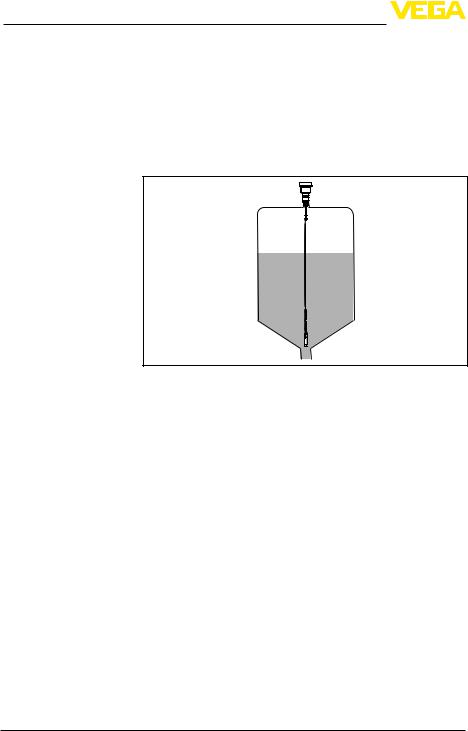
4 Mounting
vessels, the distance to the vessel wall should be at least 500 mm (19.7 in).
During operation, the probe must not touch any installations or the vessel wall.If necessary, fasten the probe end.
In vessels with conical bottom it can be advantageous to mount the sensor in the center of the vessel, as measurement is then possible nearly down to the lowest point of the bottom.Keep in mind that measurement all the way down to the tip of the probe may not be possible.The exact value of the min.distance (lower dead band) is stated in chapter "Technical data".
|
Fig. 7: Vessel with conical bottom |
Type of vessel |
Plastic vessel/Glass vessel |
|
The guided microwave principle requires a metal surface on the pro- |
|
cess fitting.Therefore use in plastic vessels etc.an instrument version |
|
with flange (from DN 50) or place a metal sheet (ø > 200 mm/8 in) |
|
beneath the process fitting when screwing it in. |
|
Make sure that the plate has direct contact with the process fitting. |
|
When installing rod or cable probes in vessels without metal walls, |
|
e.g.in plastic vessels, the measured value can be influenced by |
|
strong electromagnetic fields (emitted interference according to |
|
EN 61326:class A).In this case, use a probe with coaxial version. |
130430-EN-44640
16 |
VEGAFLEX 81 • HART - integrated accumulator |
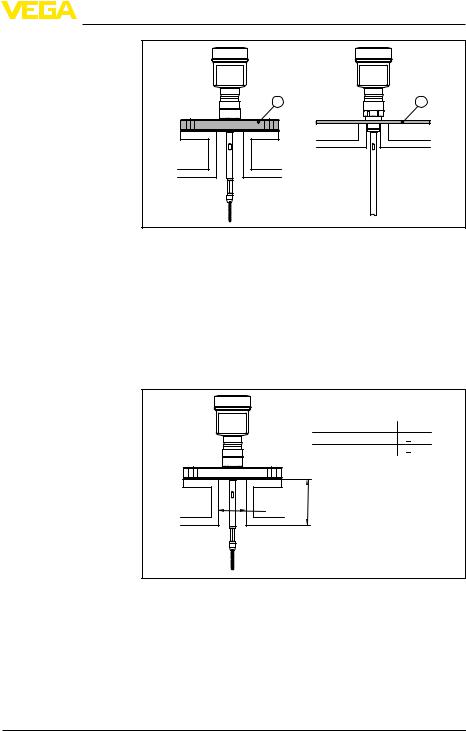
4 Mounting
1 |
2 |
Fig. 8: Installation in non-metal vessel
1Flange
2Metal sheet
Socket |
If possible, avoid sockets.Mount the sensor flush with the vessel top. |
|
If this is not possible, use short sockets with small diameter. |
Higher sockets or sockets with a bigger diameter can generally be used.They simply increase the upper blocking distance.Check if this is relevant for your measurement.
In such cases, always carry out a false signal suppression after installation.You can find further information under "Setup procedure".
|
d |
h |
|
DN40 ... DN150 |
< 150 |
|
> DN150 ... DN200 |
< 100 |
d |
h |
|
|
|
Fig. 9: Mounting socket
When welding the socket, make sure that the socket is flush to the vessel top.
44640-EN-130430
VEGAFLEX 81 • HART - integrated accumulator |
17 |
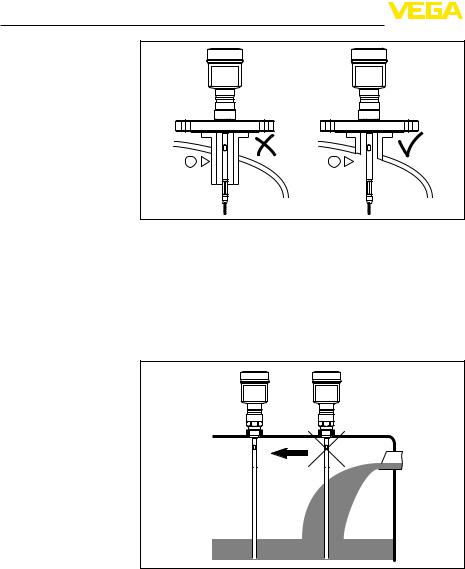
4 Mounting
|
|
1 |
2 |
|
Fig.10:Socket must be installed flush |
|
|
|
1 |
Unfavourable installation |
|
|
2 |
Socket flush - optimum installation |
|
Welding work |
Before beginning the welding work, remove the electronics module |
||
|
from the sensor.By doing this, you avoid damage to the electronics |
||
|
through inductive coupling. |
|
|
Inflowing medium |
Do not mount the instruments in or above the filling stream.Make sure |
||
|
that you detect the product surface, not the inflowing product. |
||
Fig.11:Mounting of the sensor with inflowing medium
Measuring range |
The reference plane for the measuring range of the sensors is the |
|
|
sealing surface of the thread or flange. |
|
|
Keep in mind that a min.distance must be maintained below the refer- |
|
|
ence plane and possibly also at the end of the probe - measurement |
|
|
in these areas is not possible (dead band).The length of the cable |
|
|
can be used all the way to the end only when measuring conductive |
|
|
products.These blocking distances for different mediums are listed |
|
|
|
|
18 |
VEGAFLEX 81 • HART - integrated accumulator |
|
130430-EN-44640

|
|
|
|
|
|
|
|
|
|
|
|
|
|
|
4 Mounting |
|
|
|
in chapter "Technical data".Keep in mind for the adjustment that the |
||||||||||||||
|
|
default setting for the measuring range refers to water. |
||||||||||||||
Pressure |
The process fitting must be sealed if there is gauge or low pressure in |
|||||||||||||||
|
|
the vessel.Before use, check if the seal material is resistant against |
||||||||||||||
|
|
the measured product and the process temperature. |
||||||||||||||
|
|
The max.permissible pressure is specified in chapter "Technical |
||||||||||||||
|
|
data" or on the type label of the sensor. |
||||||||||||||
Standpipes or bypass |
Standpipes or bypass tubes are normally metal tubes with a diameter |
|||||||||||||||
tubes |
of 30 … 200 mm (1.18 … 7.87 in).In measurement technology such a |
|||||||||||||||
|
|
tube corresponds to a coax probe.It does not matter if the standpipe |
||||||||||||||
|
|
is perforated or slotted for better mixing.Lateral inlets with bypass |
||||||||||||||
|
|
tubes also do not influence the measurement. |
||||||||||||||
|
|
Microwaves can penetrate many plastics.For process technical rea- |
||||||||||||||
|
|
sons, plastic standpipes are problematic.If durability is no problem, |
||||||||||||||
|
|
then we recommend the use of metal standpipes. |
||||||||||||||
|
|
When theVEGAFLEX 81 is used in standpipes or bypass tubes, |
||||||||||||||
|
|
contact with the tube wall must be avoided.We recommend for this |
||||||||||||||
|
|
purpose a cable probe with centering weight. |
||||||||||||||
|
|
Generally a spacer at the probe end is sufficient for rod probes to |
||||||||||||||
|
|
avoid contact to the tube wall.Depending on the tube diameter or |
||||||||||||||
|
|
tube length, spacers can be also mounted in the centre of the tube. |
||||||||||||||
|
|
With cable probes it is also possible to strain the cable. |
||||||||||||||
|
|
Keep in mind that buildup can form on the spacers.Strong buildup |
||||||||||||||
|
|
can influence the measurement. |
||||||||||||||
|
|
|
|
|
|
|
|
|
|
|
|
|
|
|
|
|
|
|
|
|
|
|
|
|
|
|
|
|
|
|
|
|
|
|
|
|
|
|
|
|
|
|
|
|
|
|
|
|
|
|
44640-EN-130430
1 |
2 |
3 |
Fig. 12: Position of the spacer or centering weight
1Rod probe with spacer (PEEK)
2Cable probe with centering weight
3Spacer (PEEK) on the gravity weight of a cable probe
VEGAFLEX 81 • HART - integrated accumulator |
19 |

4 Mounting
Note:
Measurement in a standpipe is not recommended for extremely adhesive products.
|
Instructions for the measurement: |
|
|
• |
The 100 % point should not be above the upper tube connection |
|
to the vessel |
|
|
• |
The 0 % point should not be below the lower tube connection to |
|
the vessel |
|
|
• |
A false signal suppression with integrated sensor is generally |
|
|
recommended to reach the maximum possible accuracy |
Fixing |
If there is a danger of the cable probe touching the vessel wall during |
|
|
operation due to product movements or agitators etc., the measuring |
|
|
probe should be securely fixed. |
|
|
In the gravity weight there is an internal thread (M8), e.g.for an eye- |
|
|
bolt (optional) - (article no.2.1512). |
|
|
Make sure that the probe cable is not completely taut.Avoid tensile |
|
|
loads on the cable. |
|
|
Avoid undefined vessel connections, i.e.the connection must be |
|
|
either grounded reliably or isolated reliably.Any undefined change of |
|
|
this requirement can lead to measurement errors. |
|
Rod extensions |
In case of difficult installation conditions, the probe can be also |
|
|
mounted laterally.For this purpose, adapt the rod with rod extensions |
|
|
or bow-shaped segments. |
|
Let the probe length determine automatically by the instrument to compensate the resulting running time changes.
The determine probe length can deviate from the actual probe length when using bow-shaped segments.
Make sure that the rod of the probe is at least 300 mm (11.811 in) away from the vessel wall
You can find further information in the supplementary instructions of the rod extension.
130430-EN-44640
20 |
VEGAFLEX 81 • HART - integrated accumulator |
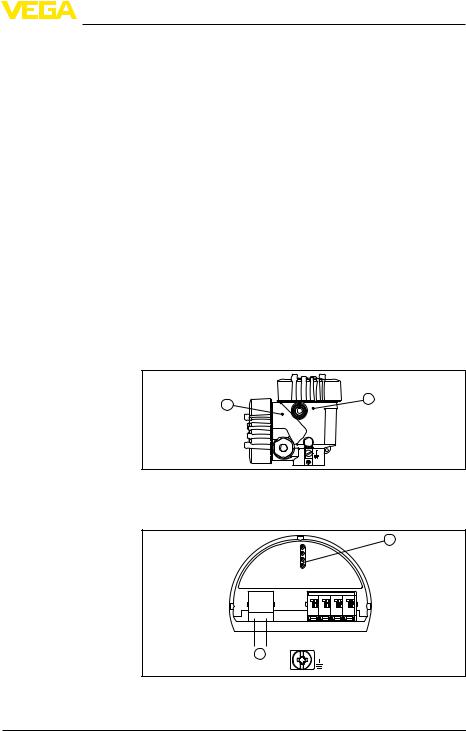
5 Connecting to power supply
5 Connecting to power supply
Cable screening and grounding
5.1Connection of the battery charger
We recommended charging the integrated accumulator completely before setting up the instrument.You can find the charging time in chapter "Technical data".
The battery charger is plugged into a socket in the supply room, see chapter "Wiring plan".
The LEDs in the supply room show the charging process and condition of the accumulator, see chapter "Wiring plan".
If screened cable is necessary, connect the cable screen on both ends to ground potential.In the sensor, the screen must be connected directly to the internal ground terminal. The ground terminal on the outside of the housing must be connected to the potential equalisation (low impedance).
If potential equalisation currents are expected, the connection on the processing side must be made via a ceramic capacitor (e.g.1 nF, 1500V).The low-frequency potential equalisation currents are thus suppressed, but the protective effect against high frequency interference signals remains.
5.2Wiring plan
Overview
1 |
2 |
|
44640-EN-130430
Fig. 13: Position of the power supply and electronics compartment
1Supply room (accumulator)
2Electronics compartment
Electronics compartment |
2 |
4...20mA
(+)1 |
2(-) |
5 6 7 8 |
|
1 |
|
Fig. 14: Electronics compartment, double chamber housing
1Internal connection to the connection compartment
2Contact pins for the display and adjustment module
VEGAFLEX 81 • HART - integrated accumulator |
21 |

5 Connecting to power supply
Supply room
2 |
|
|
1,2 OFF |
|
|
|
3 ON/OFF 1h |
9 |
0 |
2 |
4 ON/OFF |
7 |
|
3 |
5..9 auto cycle |
8 |
|
1 |
|
|
|
modes Charge Accu |
|
65 |
4 |
||
( +)1 2(-)
1
3
4
5
Fig. 15: Supply room
1Internal connection of the socket for the battery charger
2Mode switch
3LED green, charging process
4LED yellow, charging status
5Socket for the battery charger
The mode switch enables the selection of the following modes:
•
•
•
•
•
•
•
•
•
0 = sensor off, LEDs show the accumulator status 1, 2 = sensor off, LEDs off
3 = sensor on for 1 hour after pressing a key (delivery status) 4 = sensor permanently on, switching on/off via button
5 = sensor is switched on every 30 min.for 3 min. 6 = sensor is switched on every hour for 3 min. 7 = sensor is switched on every 6 hours for 3 min.
8 = sensor is switched on every 12 hours for 3 min. 9 = sensor is switched on every 24 hours for 3 min.
The green LED characterizes the charging process:
•LED flashes = Accumulator is charging
•LED lights = accumulator is full, battery charger should be unplugged (accumulator life time)
After pressing the key or changing the mode the yellow LED shows the accumulator status for approximately 10 s as follows:
•
•
•
LED lights = accumulator is full
LED flashes = accumulator should be charged LED off = accumulator is empty
5.3Switch-on phase
The instrument is switched on and off by means of a button outside on the housing.
130430-EN-44640
22 |
VEGAFLEX 81 • HART - integrated accumulator |

5 Connecting to power supply
1
Fig.16:Switch on/off button outside on the housing
1On/Off button
After switching on, the instrument carries out a self-check for approximately 30 s:
•Internal check of the electronics
•Indication of the instrument type, hardware and software version, measurement loop name on the display or PC
•Indication of the status message "F 105 Determine measured value" on the display or PC
As soon as a plausible measured value is found, it is displayed.The value corresponds to the actual level as well as the settings already carried out, e.g.factory settings.
44640-EN-130430
VEGAFLEX 81 • HART - integrated accumulator |
23 |
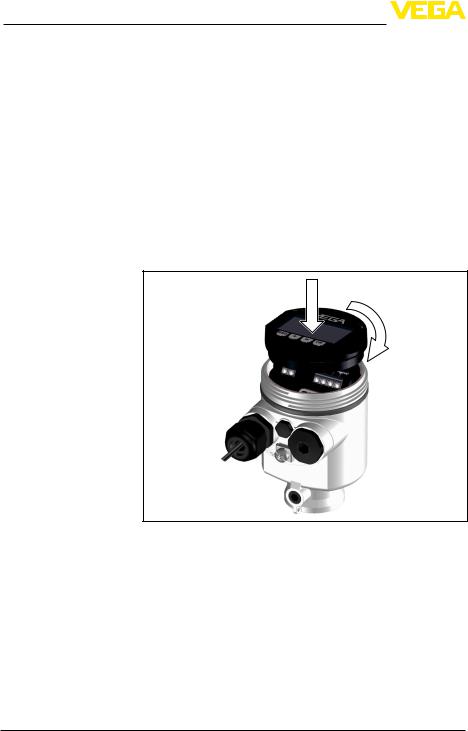
6 Set up with the display and adjustment module
6Set up with the display and adjustment module
6.1Insert display and adjustment module
The display and adjustment module can be inserted into the sensor and removed any time.Four positions displaced by 90° can be selected. It is not necessary to interrupt the power supply.
Proceed as follows:
1.Unscrew the housing cover
2.Place the display and adjustment module in the requested position onto the electronics and turn to the right until it snaps in
3.Screw housing cover with inspection window tightly back on Removal is carried out in reverse order.
The display and adjustment module is powered by the sensor, an additional connection is not necessary.
Fig. 17: Insertion of the display and adjustment module with single chamber housing into the electronics compartment
130430-EN-44640
24 |
VEGAFLEX 81 • HART - integrated accumulator |
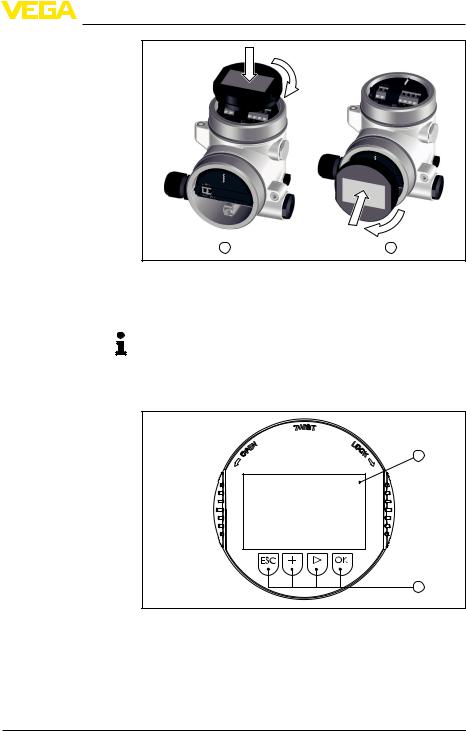
6 Set up with the display and adjustment module
44640-EN-130430
1 |
2 |
Fig. 18: Insertion of the display and adjustment module with double chamber housing
1In the electronics compartment
2In the connection compartment (with Ex-d-ia version not possible)
Note:
If you intend to retrofit the instrument with a display and adjustment module for continuous measured value indication, a higher cover with an inspection glass is required.
6.2Adjustment system
1
2
|
Fig. 19: Display and adjustment elements |
|
||
|
1 |
LC display |
|
|
|
2 |
Adjustment keys |
|
|
Key functions |
• |
[OK] key: |
|
|
|
|
–– |
Move to the menu overview |
|
|
|
–– |
Confirm selected menu |
|
|
|
–– Edit parameter |
|
|
VEGAFLEX 81 • HART - integrated accumulator |
25 |
|||

6 Set up with the display and adjustment module
|
• |
–– |
Save value |
|
|
[->] key: |
|||
|
–– |
Presentation, change measured value |
||
|
|
–– |
Select list entry |
|
|
• |
–– |
Select editing position |
|
|
[+] key: |
|||
|
• |
–– |
Change value of the parameter |
|
|
[ESC] key: |
|||
|
–– |
Interrupt input |
||
|
|
–– |
Jump to next higher menu |
|
Adjustment system |
The sensor is adjusted via the four keys of the display and adjust- |
|||
|
ment module.The LC display indicates the individual menu items.The |
|||
|
functions of the individual keys are shown in the above illustration. |
|||
|
Approx.10 minutes after the last pressing of a key, an automatic reset |
|||
|
to measured value indication is triggered.Any values not confirmed |
|||
|
with [OK] will not be saved. |
|||
Switch-on phase |
After switching on, theVEGAFLEX 81 carries out a short self-test |
|||
|
where the device software is checked. |
|||
|
The output signal transmits a fault signal during the switch-on phase. |
|||
|
The following information is displayed on the display and adjustment |
|||
|
module during the startup procedure: |
|||
|
• |
Instrument type |
||
|
• |
Device name |
||
|
• |
Software version (SW-Ver) |
||
|
• |
Hardware version (HW-Ver) |
||
Measured value indica- |
With the [->] key you can move between three different indication |
|||
tion |
modes. |
|||
|
In the first view, the selected measured value and a respective bar- |
|||
|
graph presentation are displayed. |
|||
|
In the second view, the selected measured value as well as a second |
|||
|
selectable value, e.g.the temperature value are displayed. |
|||
|
In the third view, the selected measured value is displayed in large |
|||
|
letters. |
|||
|
6.3 Parameter adjustment - Quick setup |
|||
Quick setup |
To quickly and easily adapt the sensor to the application, select |
|||
|
the menu item "Quick setup" in the start graphic on the display and |
|||
|
adjustment module. |
|||
|
|
|
|
|
26 |
|
|
VEGAFLEX 81 • HART - integrated accumulator |
|
130430-EN-44640

44640-EN-130430
6 Set up with the display and adjustment module
|
You can find "Extended adjustment" in the next sub-chapter. |
General information |
Measurement loop name |
|
In the first menu item you can assign a suitable measurement loop |
|
name.You can enter a name with max.19 characters. |
|
Medium type |
|
In the next menu item you can see which product type the instrument |
|
is suitable for.If your instrument is only suitable for a certain medium, |
|
this menu item is not visible. |
|
Applications |
|
In this menu item, you can select the application.You can choose |
|
between level measurement and interface measurement.You can |
|
also choose between measurement in a vessel or in a bypass or |
|
standpipe. |
Level measurement |
Medium - dielectric constant |
|
In this menu item, you can define the medium type (product). |
|
Max. adjustment |
|
In this menu item, you can enter the max.adjustment for the level. |
|
Enter the appropriate distance value in m (corresponding to the |
|
percentage value) for the full vessel.The distance refers to the sensor |
|
reference plane (seal surface of the process fitting).Keep in mind that |
|
the max.level must lie below the dead band. |
|
Min. adjustment |
|
In this menu item, you can enter the min.adjustment for the level. |
|
Enter the suitable distance value in m for the empty vessel (e.g. |
|
distance from the flange to the probe end) corresponding to the per- |
|
centage value.The distance refers tot he sensor reference plane (seal |
|
surface of the process fitting). |
Interface measurement |
Dielectric constant - upper medium |
|
|
In this menu item, you can define the medium type (product). |
|
|
Max. adjustment |
|
|
In this menu item, you can enter the max.adjustment for the level. |
|
|
Enter the appropriate distance value in m (corresponding to the |
|
|
percentage value) for the full vessel.The distance refers to the sensor |
|
|
|
|
VEGAFLEX 81 • HART - integrated accumulator |
27 |
|
